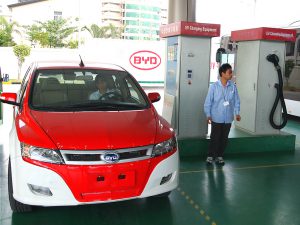Last week, an unusual group gathered in the Rachel Carson room of the Environmental Protection Administration (EPA) in Washington DC. Scandal-plagued EPA Administrator Scott Pruitt took time out from answering questions about corruption, to speak to a specially selected audience of car company executives, lobbyists, and members of right-wing think-tanks.
Rachel Carson, the author of Silent Spring, was famous for chronicling environmentally destructive behaviour by American businesses. In her room, Pruitt announced that the Trump Administration would weaken fuel efficiency standards for new cars and trucks, potentially ushering in a new generation of polluting, old-fashioned vehicles, the iconic American “gas guzzlers” that many thought would soon become a thing of the past.
Pruitt’s announcement is bad news for American public health, the climate, and, most likely, the competitiveness of American car manufacturers. Transportation is the largest single source of air pollution in the United States. Particulate matter, a major pollutant from motor vehicles, contributes to up to 30,000 premature deaths each year, as well as to conditions like asthma and bronchitis. Transport is also now the largest source of greenhouse gas emissions, which cause climate change, in America.
The public
Introducing stricter fuel economy standards was arguably the most significant thing former President Obama achieved on climate change. The new standards were set to come into force for cars built between 2022 and 2025, increasing average fuel economy from 35 miles per gallon for cars and trucks to between 50 and 52.6 miles per gallon by 2025. If implemented they could reduce carbon dioxide emissions by about six billion tonnes while cutting oil consumption by about 12 billion barrels.
Existing fuel efficiency standards have enjoyed broad support from the public, a recent survey found that Nearly 7 in 10 voters want the EPA to leave current standards in place. People are not just motivated by concern about their lungs, their pockets matter too. A new car meeting 2025 standards would save a consumer about US$4,000 (25,200 yuan) in fuel costs over the life of the vehicle compared to the average car meeting the weaker, 2017 standards.
The lobbyists
Car companies lobbied hard for lower standards. The Alliance of Automobile Manufacturers, a trade association which represents major American and international car companies, resorted to denying the science of climate change as part of its efforts. Publicly, many Alliance members have continued their own commitments to manufacturing cleaner cars, including electric vehicles, allowing their trade association to do the dirty work.
However, these companies may have bitten off more than they can chew with the Trump Administration. Bill Ford, an executive for Ford Motors, claimed that his company did not support such extensive cuts, arguing they just wanted a single national fuel economy standard. In America’s federal system, certain states, notably California, are able to set their own standards.
Stricter standards for California
California’s exemption dates to the 1970s when air pollution was a particularly serious problem in the state. Californian standards are stricter than national standards. On top of this, 12 other states and Washington DC, follow them. When added to California, that’s an area with a combined population of approximately 113 million people, roughly a third of Americans.
Pruitt’s announcement sets the stage for a legal showdown between California and the Trump Administration. Pruitt hopes to bring California and its followers in line with the rest of the country, potentially going as far as to revoke California’s right to set its own standards. California says it will sue in response.
It’s not clear how this fight will end. There’s some suggestion that the manufacturers will step in to broker a less damaging deal. But the outcome is unlikely to be better for the climate or American health than existing regulations. Meanwhile, Ford, and others, are now contemplating the less profitable prospect of making different cars for different parts of the country.
Trade tariffs
The Trump Administration’s trade policies are also a wild card here. It has already begun implementing a wide-ranging programme of tariffs designed, supposedly, to protect American industry.
The Wall Street Journal reported late last week that new trade barriers were being considered, designed to favour car companies that manufactured vehicles in the United States. Ironically, imported vehicles may actually end up facing higher environmental standards. But this would be no act of altruism. The policy would aim to shift manufacturing to the US, and to encourage consumers to buy dirtier, American-made vehicles.
But lower standards in America are unlikely to help the competitiveness of American car manufacturers overseas. The market for cleaner cars, especially electric vehicles, is expected to grow rapidly in the coming decade. Chinese and some European manufacturers are betting big on fuel efficient and electric vehicles. China already boasts half of global hybrid and electric vehicle sales, and electric vehicles have already displaced 1.5% of oil demand.
In Silent Spring Rachel Carson wrote: “Our heedless and destructive acts enter into the vast cycles of the earth and in time return to bring hazard to ourselves.” With this deliberate decision to increase pollution, Scott Pruitt has put people’s lives at risk.








![Shahzad Qureshi standing inside his urban forest [image by: Zofeen T. Ebrahim]](https://dialogue.earth/content/uploads/2018/04/IMG_1295-300x225.jpg)
